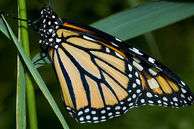Monarch butterflies appear to use medicinal plants to treat their offspring for disease, research by biologists at Emory University shows. Their findings were published online Oct. 6 in the journal Ecology Letters.
"We have shown that some species of milkweed, the larva's food plants, can reduce parasite infection in the monarchs," says Jaap de Roode, the evolutionary biologist who led the study. "And we have also found that infected female butterflies prefer to lay their eggs on plants that will make their offspring less sick, suggesting that monarchs have evolved the ability to medicate their offspring."
Few studies have been done on self-medication by animals, but some scientists have theorized that the practice may be more widespread than we realize. "We believe that our experiments provide the best evidence to date that animals use medication," de Roode says.
"The results are also exciting because the behavior is trans-generational," says Thierry Lefevre, a post-doctoral fellow in de Roode's lab. "While the mother is expressing the behavior, only her offspring benefit. That finding is surprising for monarch butterflies."
The findings also may have implications for human health, says University of Michigan chemical ecologist Mark Hunter, who collaborated with de Roode's group on the research.
"When I walk around outside, I think of the plants I see as a great, green pharmacy," Hunter says. "But what also strikes me is how little we actually know about what that pharmacy has to offer. Studying organisms engaged in self-medication gives us a clue as to what compounds might be worth investigating for their potential as human medicines." (Petty spurge, pictured left, clears most common type of skin cancer.)
Monarch caterpillars feed on any of dozens of species of milkweed plants, including some species that contain high levels of cardenolides. These chemicals do not harm the caterpillars, but make them toxic to predators even after they emerge as adults from their chrysalises.
Previous research has focused on whether the butterflies choose more toxic species of milkweed to ward off predators. De Roode wondered if the choice could be related to the Ophryocystis elektroscirrha. The parasites invade the gut of the caterpillars and then persist when they become adult monarchs. An infected female passes on the parasites when she lays her eggs. If the adult butterfly leaves the pupal stage with a severe parasitic infection, it does not live as long as uninfected ones.
Experiments in de Roode's lab have shown that a female infected with the parasites prefers to lay her eggs on a toxic species of milkweed, rather than a non-toxic species. Uninfected female monarchs, however, showed no preference.
De Roode recently received a $500,000 grant from the National Science Foundation, which he will use to see if the lab results can be replicated in nature, in different populations of monarchs in various regions of the world. Hunter received $150,000 from the NSF to identify the chemicals that account for the medicinal properties of the milkweed plants.
(Source: Emory.edu)










Be the first to comment